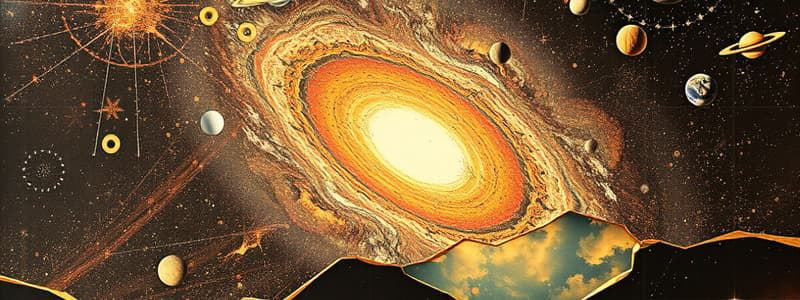Podcast
Questions and Answers
Match the scientific fields with their main focus:
Match the scientific fields with their main focus:
Astronomy = Study of celestial objects and phenomena Cosmology = Origin and evolution of the universe Physics = Fundamental principles of matter and energy Meteorology = Study of atmosphere and weather patterns
Match the concepts with their descriptions:
Match the concepts with their descriptions:
Big Bang = Origin point of our universe Cosmic Background Radiation = Evidence of the early universe Singularity = Point of infinite density and temperature Energy State = Initial conditions of the universe at the Big Bang
Match the stages of the universe with their characteristics:
Match the stages of the universe with their characteristics:
Initial State = Extremely hot and dense Formation of Matter = Too hot for stable atoms to form Expansion = Increasing volume of the universe Cosmic Timeline = History of the universe from Big Bang to present
Match the terms with their definitions:
Match the terms with their definitions:
Match the events with their significance in cosmology:
Match the events with their significance in cosmology:
Match the following Earth systems with their definitions:
Match the following Earth systems with their definitions:
Match the layers of the Earth with their order:
Match the layers of the Earth with their order:
Match the mineral formation types with their descriptions:
Match the mineral formation types with their descriptions:
Match the properties of minerals with their types:
Match the properties of minerals with their types:
Match the following layers of the Earth with their descriptions:
Match the following layers of the Earth with their descriptions:
Flashcards are hidden until you start studying
Study Notes
Origin of the Universe and Time, Energy, and Matter
- Astronomy is the scientific study of celestial objects beyond Earth's atmosphere including stars, planets, comets, and galaxies.
- Cosmology is a subfield of astronomy focusing on the origin and the evolution of the universe.
- The Big Bang theory proposes that time began approximately 13.8 billion years ago, marking the universe's origin.
- Before the Big Bang, conventional notions of time and space did not exist.
- Initially, the universe was in a hot and dense state with energy concentrated in a singularity, characterized by infinite density and temperature.
Cosmic Timeline
- The Big Bang Theory outlines the sequence of events from the initial singularity to the present universe.
- A closed system (like Earth) only exchanges heat, receiving energy from the Sun and returning energy to space.
Earth Systems and Layers
- The geosphere refers to Earth's solid components:
- Crust
- Upper Mantle
- Mantle
- Outer Core
- Inner Core
- The biosphere is the zone where life exists on Earth.
Rocks and Minerals
- Minerals are naturally occurring, inorganic compounds usually found in crystalline form.
- Mineralogy studies the formation, occurrence, and properties of minerals.
- Minerals can crystallize from magma or precipitate from solutions:
- Crystallization: Solidification of liquid magma or lava.
- Precipitation: Dissolved minerals forming solids from water.
Properties of Minerals
- Streak: The color of a mineral in powdered form, tested on porcelain.
- Density: Calculated as mass divided by volume of the mineral.
- Crystal Shape: Characteristic shape of crystals or combinations of crystals.
- Tenacity: The toughness of a mineral against breaking or deforming.
- Hardness: Resistance to abrasion or scratching.
- Cleavage: The way minerals split along specific planes.
Types of Minerals
- Silicates: Rock-forming minerals containing oxygen and silicon, including:
- Feldspar (50% of Earth’s crust)
- Quartz (composed of silicon and oxygen)
- Non-silicates: Less abundant, including minerals like oxides, carbonates, sulfates, and halides.
Geological Processes
- Exogenic Processes: External Earth processes, involving the atmosphere, hydrosphere, and biosphere.
- Endogenic Processes: Internal Earth processes that drive geological phenomena.
Types of Rocks
- Igneous Rocks: Form from crystallized magma/lava; can be either extrusive (volcanic) or intrusive (plutonic).
- Sedimentary Rocks: Created from compacted sediments; formed through deposition and cementation.
- Metamorphic Rocks: Originated from existing rocks altered by heat, pressure, or mineral exchange, including processes of metamorphism.
Weathering Processes
- Mechanical Weathering: Breaks down rocks into smaller pieces without altering their chemical composition.
- Chemical Weathering: Involves the chemical decomposition of rocks.
- Magma: A hot, viscous mixture of molten and semi-molten rock beneath the Earth's surface.
Principles of Stratigraphy
- Principle of Superposition: In an undisturbed layer of stratified rocks, each layer is older than the one above it.
- Principle of Original Horizontality: Sediments are deposited horizontally due to gravity.
- Principle of Lateral Continuity: Sedimentary rocks spread continuously over large areas until interrupted by barriers or erosion.
Dating Techniques
- Relative Dating: Sequencing geological events based on the arrangement of sedimentary rocks.
- Absolute Dating: Determining the actual age of rocks and fossils for better chronological understanding.
Studying That Suits You
Use AI to generate personalized quizzes and flashcards to suit your learning preferences.




